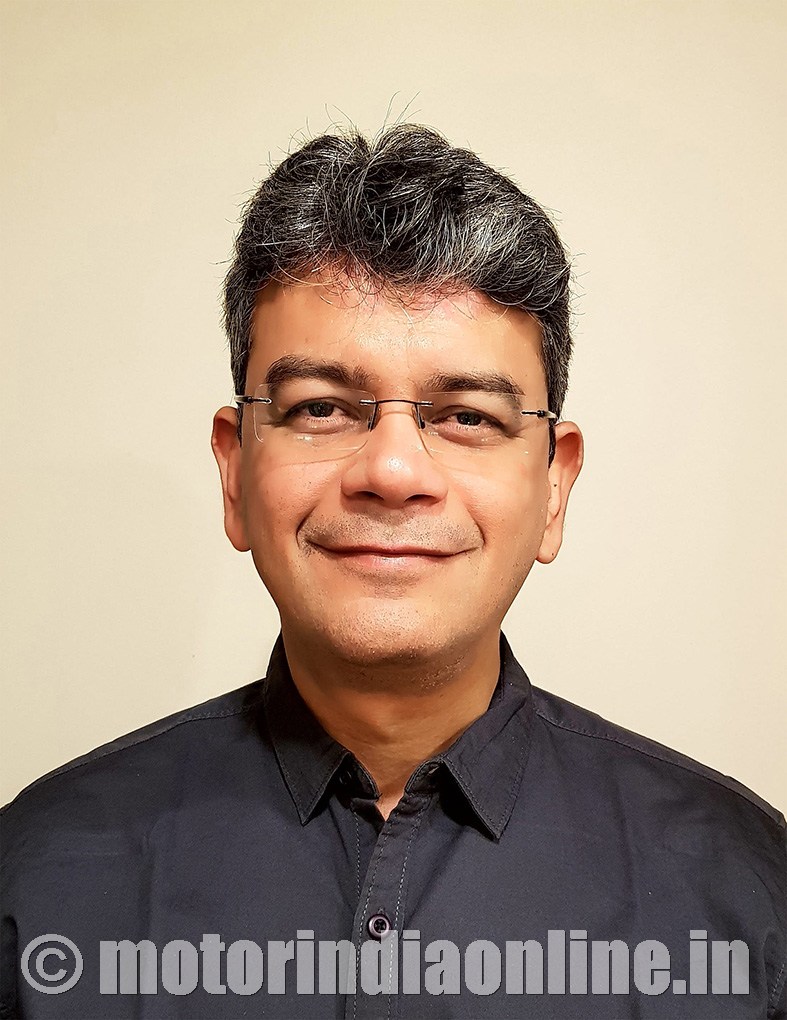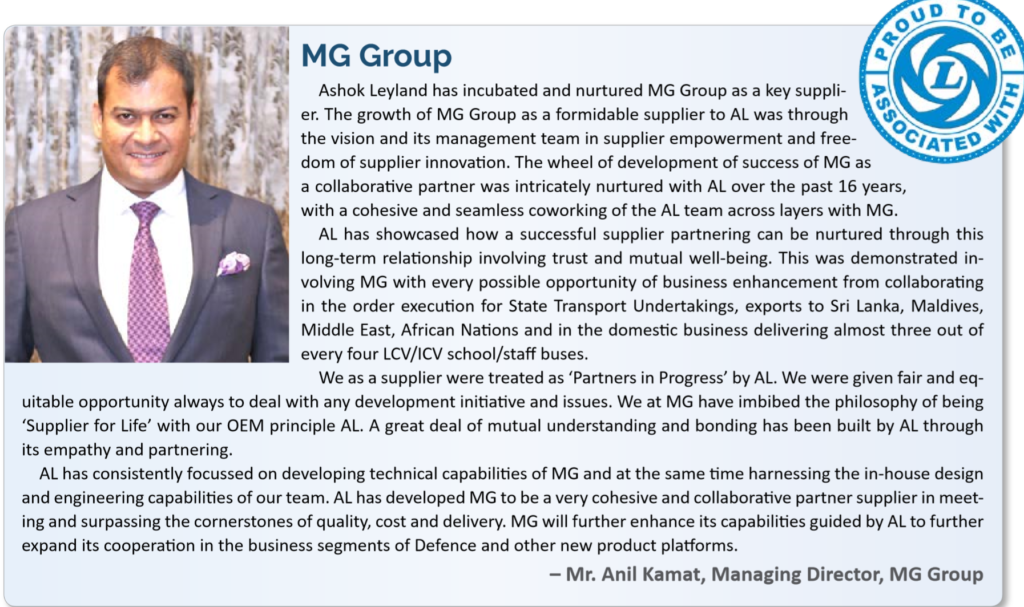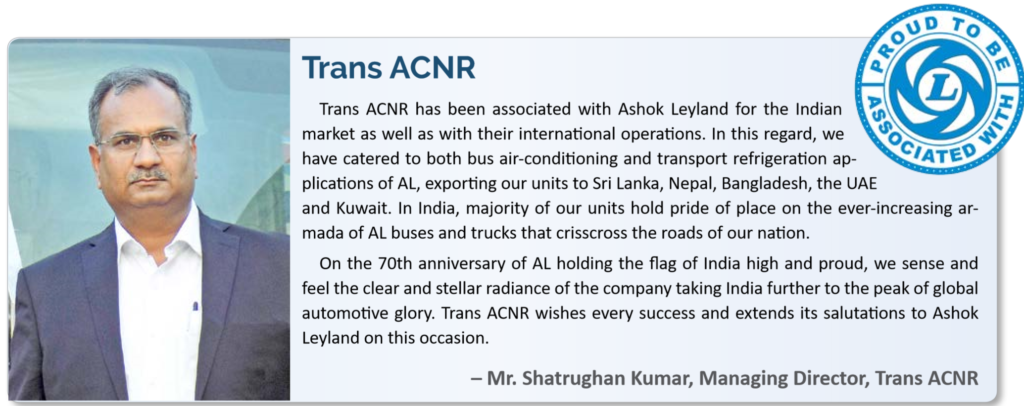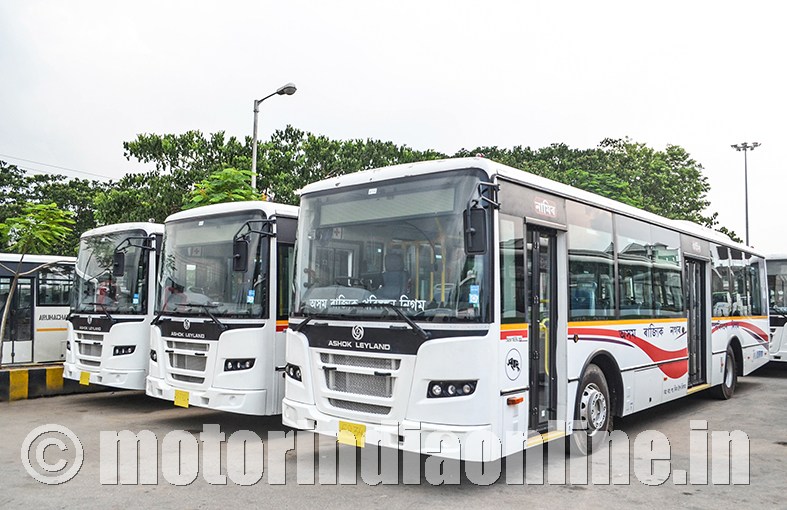“As for the fully built bus, we do not wish to wait for the customers to change but want to lead the market change. We are keen to supply the vehicle of consistent quality at an affordable price and are building production capacity and developing design capabilities to achieve the goal,” states Mr. Sanjay Saraswat, Sr. Vice President – Global Buses, Ashok Leyland Ltd. (AL).

Excerpts:
AL is synonymous with trucks and buses in the M&HCV segment. On the occasion of its 70th anniversary, can you share the important milestones crossed and the future plans?
There are plenty of anecdotes to share for sure, but I consider AL reaching the world’s 4th ranking in buses as a great milestone. Our corporate vision is to be one among the top 5 in the world, and we are already there and sustaining it for over 4 years. Also we have been consistently No.1 in the domestic bus market, and exports are also on the rise. Today we have 1 in 3 buses supplied going for export.
We want to achieve the target of 1 bus in exports for every 1 supplied in the domestic market.
Our main focus now is to change the way the buses are bought in this country, viz., by offering to customers fully built bus (FBB).
Of course, there are capable body builders in the country who build the buses on the chassis procured to suit the customer needs. But the customer thinking is changing fast as in the passenger car segment, and also companies are pushing for it. With this developing trend, we want to be identified as a bus manufacturer and not as chassis manufacturer. The challenge is in how to segment the market and brand it accordingly.
Whether AL builds the bus at its plants or gets it done through the approved vendors is an internal business decision. We want to offer the customer the FBB and take responsibility for the guarantees of supplies.
Can you elaborate the production facilities, market for varied segments and the USPs to sustain the growth phase?
We already have our plant at Alwar, Rajasthan, manufacturing buses for the ICV segment, and Globlal TVS, Tiruchi, a joint venture company of AL engaged for body building to meet the customer needs. Also the new greenfield manufacturing plant near the upcoming capital city Amravati, for which the foundation stone was laid recently, will become operational in about 6 months.
It will be important to mention here that our Ras Al Khaimah plant in the UAE has full-fledged facilities to manufacture buses, and last year built around 400 buses a month to meet demand. Domestic market TIV for buses last year was 37,000 and AL supplied 13,700, and also exported about 6,500 buses.
Domestic market can be broadly classified under private and STU sectors, and within it further looked at as ICV and MCV areas. Thus in the 2X2 matrix, our comfort lies in the private MCV segment with a 65% share and have a relatively lower presence, 25% in the ICV segment.
As regards USPs, when we talk to the customers a few things stand out. Firstly, they say AL buses keep running without any problems. This means benefits both to the customers and the fleet operator – the customers not having any issues during travel and the operator earning more money and as well retaining customers in his fold.
Secondly, our fuel efficiency ensures that the operator achieves a better TCO which is the key issue in bus business. Thus reliability, durability and lower TCO enable AL to sustain the growth. Also other factors like excellent field service and spares support enable operators to opt for AL products.
Comment on the conventional bodybuilding route and the evolving space frame design gaining market acceptance.
In the ICV segment, 60% of the buses supplied are our own with full guarantees, and we want this to become 100% and the volumes also more than double. In the MCV segment, FBB supplies are very low and we invariably supply the chassis to body builders to meet the customer needs. In the export segment, we supply the chassis kits for assembly to our facility or associate’s assembly facility in that country – to meet the local body building preferences. In the chassis supply route our responsibility lies with chassis, and the body builder takes the responsibility for the super structure work.
On the exports front, we address such of those markets where buses built on conventional chassis are needed. We export to Bangladesh, Sri Lanka, Nepal and supply to the Gulf region through the RAK plant. Yes, the space frame designs are making an entry, especially in multi-axle buses, and we do not address this segment currently.
This is a niche market with price almost three times that of a feature-rich 2-axle bus. We will enter this segment at an appropriate point of time in the future.
Tell us how AL managed the transition to BS-IV regulations early last year and planning to address BS-VI in 2020.
To meet the BS-IV, we recalled the chassis already with our dealers to do the modifications and incorporating iEGR. This was the route followed by AL though defensive, rather than throwing away money by giving big discounts to clear the stock, and the change was managed well. The very fact that our products are being increasingly sought after by customers goes to prove the acceptance for the iEGR methodology of AL.
Unlike in the BS-IV transition wherein as per the SC ruling sale was not allowed after April 1, 2017, in BS-VI transition, the time frame is well defined. The registration cut-off date for vehicles manufactured before April 2020 will be June 30 and for buses it will be September 30. We see no major issues in the transition.
Also to be noted herein, it’s not enough that only OEMs and oil companies get set for the shift, but customers will have to be ready as well to pay a higher price for the technology inputs and design modifications to be carried out in the vehicle to meet the emission norms.
Against the increasing road speeds, what safety measures are considered in buses? Brief us the approach plan of AL towards EV technology disruption in intra-city buses.
Safety issues are critical, be it a truck or a bus. AL, besides conforming to all the norms, has always endeavored to give more ahead of time. Take for example, the Sunshine school bus, which is a roll-over compliant design, has frontal crash protection, low fixed step entry and emergency exits. Anti-bacterial interiors, window guard rails, seat & roof grab handles, seat belts, and bus tracking & internal surveillance cameras are some of the several special features offered.
As regards the imminent shift towards EV, the manufacturers all over the world are moving in this direction, and I presume it must be the right move. Right now the cost factor is the main hurdle, but eventually it will come down. In the Indian context everyone is in the learning phase, and we have received an order from Ahmedabad for 50 buses to be run on per km basis, all costs inclusive.
We want to put the first bus on road to get the experience and all options of technologies regarding charging infrastructure are open to our design. In the EV route, it is important and right to take the entire cycle for pollution comparisons, viz., well to wheel rather than only the tank to wheel considerations. Diesel and CNG will continue to play a key role for the Indian mobility needs till the EV technology becomes competitive.

